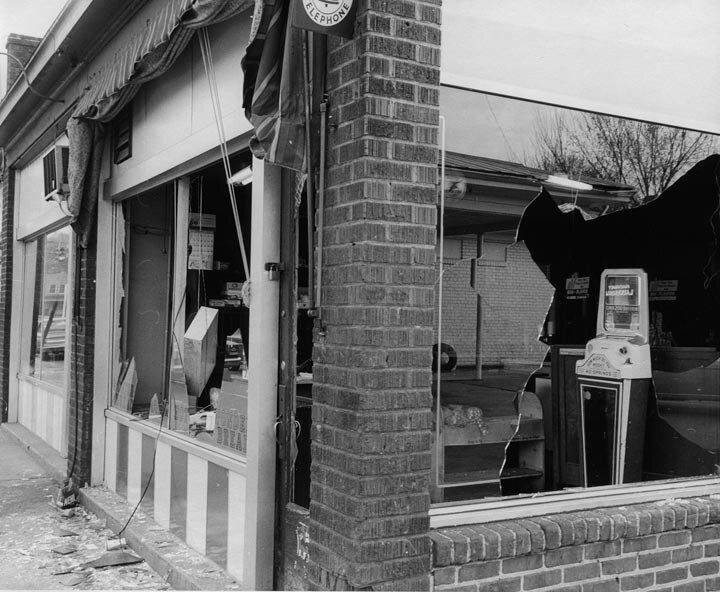Spring 2014
One

Spring 2014
One
Two
Three
One
Broken windows in a corner store in downtown Richmond, Virginia as a result of riots following the assassination of Dr. Martin Luther King, Jr.
Credit — Netherwood, photographer, Richmond Times-Dispatch Collection, The Valentine
Two
A group of riot police arrest an African-American man during riots in Richmond, Virginia following the assassination of Dr. Martin Luther King, Jr.
Credit — Richmond Times-Dispatch Photograph Collection, The Valentine
Three
A large rally being held in response to race riots after the assassination of Martin Luther King, Jr. at the Virginia State Capitol grounds in Richmond, Virginia
Credit — Amir Pishdad, photographer, Richmond Times-Dispatch Collection, The Valentine
Hayley Gray-Hoehn plays an upper-crust Richmonder appalled by her daughter’s college activities.
Hayley Gray-Hoehn, Katherine Malanoski, Karolina Castro, Alan Corbett, Andrew Jones, (l-r bottom) Kelsey Mickelson, Vivian Barnes.
From left: Katherine Malanoski, Kelsey Mickelson, Alan Corbett, Karolina Castro, Hayley Gray-Hoehn, and Andrew Jones. The set was designed by Hayley’s mother, and constructed by Hayley and Kelsey.
01
We led a docudrama course in the spring of 2014 about how Richmonders experienced 1968, a pivotal year in American history. Kaleidoscope: Richmond 1968 was set in Monroe Park, located at the nexus of VCU, a large, then-new state university; Oregon Hill, the center of Ku Klux Klan activity in the city; Jackson Ward, once known as the “Harlem of the South,” and the glamorous Prestwould apartment building.
02
We approached this historic moment by gathering information from a wide variety of sources and perspectives: newspaper articles, civil rights film footage, archival photographs, popular culture, printed ephemera, and scholarly monographs documenting how Richmonders experienced this year. Most importantly, we read transcripts of interviews with Richmonders who lived through the civil rights era, and conducted oral history interviews of our own.

An article on the "uprisings" taking place in universities across the nation after the assassination of Dr. Martin Luther King. From The Proscript, the student newspaper of The Richmond Professional Institute (RPI), published from 1939 until May of 1969.
From VCU Libraries Special Collections.
A collage of images which documents the civil unrest taking place in the city of Richmond after the death of Dr. Martin Luther King. From The Sunflower, Richmond's first underground newspaper, which premiered in 1967.
From VCU Libraries Special Collections.

Cover and page from an FBI-authored Black Panther coloring book depicts African-American children shooting police officers represented as pigs.
Credit — The Valentine.

Joe Crenshaw and members of the SCLC (Southern Christian Leadership Conference) protest racism at Fort Lee in Petersburg, Virginia.
Credit — Don Long, photographer, Richmond Times-Dispatch Collection, The Valentine

African-American students read as they stage a sit-in at a Woolworth’s in a Richmond, Virginia during the early 1960s.
Credit — Anderson Collection, The Valentine
03
Students performed Kaleidoscope at the Black Iris Gallery, a few blocks from Monroe Park, the play’s setting. The gallery had on exhibit a wide array of Richmond police surveillance records from the 1960s and 1970s that had recently been rescued from a dumpster. These materials included police informants’ reports on community activists and police photographs of Stokely Carmichael’s visit to Richmond, as well as surveillance images of other activists and protests. Audience members were able to pore over these images and text before and after the performance.
Our post-performance discussion panel was moderated by historian Julian Hayter, and included student Vivian Barnes, Richmond magazine editor Harry Kollatz, archivist Ray Bonis of VCU Special Collections, and one of our oral history interviewees, Chuck Wrenn, who had hosted Bruce Springsteen on his living room floor in 1968.